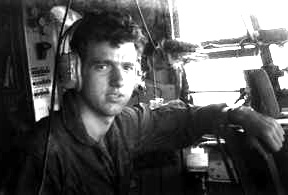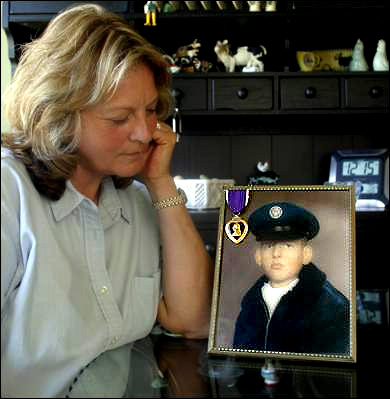
Jimmy Caniford, whose plane was shot down in Laos 36 years ago.
Vietnam vet's remains found 36 years later
Burial to be at Arlington National Cemetary

Diane
Di
Loreto,
of
Alva
looks
at
a
picture
of
her
brother,
Jimmy
Caniford,
whose
plane
was
shot
down
in
Laos
36
years
ago.
_______________________
But, instead of growing into middle age, getting married, having kids and grand kids, Caniford died when his aircraft was shot down over Laos on March 29, 1972, five months before his 24th birthday.
His body was not recovered, and for 36 years, he was listed as missing in action.
Last month, Caniford’s family learned his remains had been recovered at the crash site. He will be buried at Arlington National Cemetery.
“This means we’ll finally have a place to go where he’s going to be,” Caniford’s father Jim of Fort Myers said. “The overworked expression ‘closure’ is the one I want to use. It’s a finalization of the unknown we’ve lived with for so many years.”
As soon as he graduated from Middletown High School in Frederick County, Md., Jimmy Caniford enlisted in the Air Force at the age of 17 — he had to get written permission from his parents.
After basic training, he volunteered to fight in Vietnam.
As an AC-130 Hercules gunship illuminator operator, Staff Sgt. Caniford flew missions over Vietnam out of the Philippines — the AC-130’s primary missions were close air support and armed reconnaissance; the illuminator operator’s job was to shoot illumination flares, watch for enemy anti-aircraft positions and drop smoke to mark targets for F-4D fighters.
When his enlistment was up, Caniford re-upped and was assigned to the 16th Special Operations Squadron at Ubon Air Force Base in Thailand.
“He believed 120 percent that we were doing the right thing in Vietnam,” said Caniford’s sister Diana DiLoreto, 58, of Alva. “He felt we were making a huge difference. If somebody didn’t believe it and talked to him, he changed their mind.”
On
March
29,
1972,
Caniford’s
plane,
whose
call
sign
was
Spectre
13,
took
off
for
a
night
mission
over
North
Vietnamese
supply
routes
in
Laos.
At
about
3
a.m.,
Spectre
13
was
attacking
an
enemy
convoy
when
it
was
hit
by
a
surface-to-air
missile.
Spectre
13
crashed
in
the
jungle,
and
the
pilot
of
an
F-4D
flying
low
over
the
burning
wreckage
saw
no
sign
of
survivors.
Less
than
an
hour
after
the
crash,
a
Forward
Air
Controller
arrived
at
the
site
to
control
search
and
rescue
efforts.
The
Caniford
family
received
word
March
30
Jimmy
Caniford’s
plane
had
been
shot
down.
Jimmy
Caniford’s
youngest
sister,
Shelly,
was
living
with
her
parents;
Diana
lived
three
blocks
away;
their
father
was
at
work;
their
mother
was
at
their
grandmother’s
house,
painting
the
kitchen.
“The
Air
Force
knocked
at
my
parents’
door,
and
my
sister
knew
immediately
something
had
happened
to
Jimmy,”
DiLoreto
said.
“She
called
me
to
get
our
grandmother’s
address.
I
was
still
sleepy
and
didn’t
ask
why.
“Then
she
called
back.
She
was
crying
hysterically
and
said
Jimmy’s
plane
had
been
shot
down.
I
flew
out
of
bed,
dressed
in
about
a
minute
and
ran
to
the
house.”
By
6
p.m.
March
30,
none
of
the
Spectre
13
crew
had
been
found,
and
the
search
was
called
off.
All
14
crewmen
were
listed
as
missing
in
action.
“Days
turned
into
weeks,
weeks
into
months,
months
into
years,
and
years
into
decades,”
DiLoreto
said.
“You
live
with
hope.
You
rely
on
your
faith.
Every
day
you
still
carry
a
glimmer
of
hope.
Without
it,
you’re
letting
your
brother
down.
When
we
were
told
they’d
found
Jimmy,
it
was:
OK,
we
can
blow
out
that
light.”
Before
the
Canifords
could
blow
out
the
light,
however,
they
endured
36
years
of
uncertainty.
Seven
years
after
Spectre
13
was
shot
down,
Jimmy
Caniford
was
officially
pronounced
dead
and
his
name
went
up
on
the
Vietnam
Veterans
Memorial
in
Washington,
D.C.
In
February
1986,
a
team
from
the
United
States
and
Laos
excavated
the
crash
site
and
recovered
remains
of
nine
crewmen,
none
of
them
Caniford’s.
“Mom
got
sick
after
Jimmy
was
shot
down;
her
health
deteriorated,”
DiLoreto
said.
“She
said
the
only
way
she
could
live
with
this
is
to
pray
he
died
rather
than
being
a
prisoner.
But
the
next
day,
she’d
say
if
he’s
a
prisoner,
he
might
get
out.
It
was
constant
turmoil.
You
have
to
live
with
it.
You
have
to
find
a
way
to
cope.”
Finally,
on
March
18,
the
Canifords
received
word
a
recent
excavation
of
Spectre
13’s
crash
site
had
recovered
Jimmy
Caniford’s
remains.
“I
always
thought
it
would
be
nice
if
we
had
a
place
to
put
flowers
on
a
grave,”
DiLoreto
said.
“I
really
didn’t
think
this
would
happen
in
my
parents’
lifetime.
I
thought
he’d
greet
them
in
heaven
or
something.”
Although
Jimmy
Caniford’s
remains
have
been
recovered,
and
his
family
can
now
use
the
overworked
expression
“closure,”
they
still
feel
the
turmoil
and
will
always
grieve
for
the
young
man
who
would
have
been
60
in
August.
“Growing
up,
Jimmy
was
my
best
friend,”
DiLoreto
said.
“He
was
a
great
brother
and
a
great
man.
He
would
have
been
a
great
father.
“If
he
had
a
dollar
in
his
pocket,
he
bought
you
something.
He
was
very
unselfish.
Obviously
he
was
unselfish:
He
gave
his
life
for
what